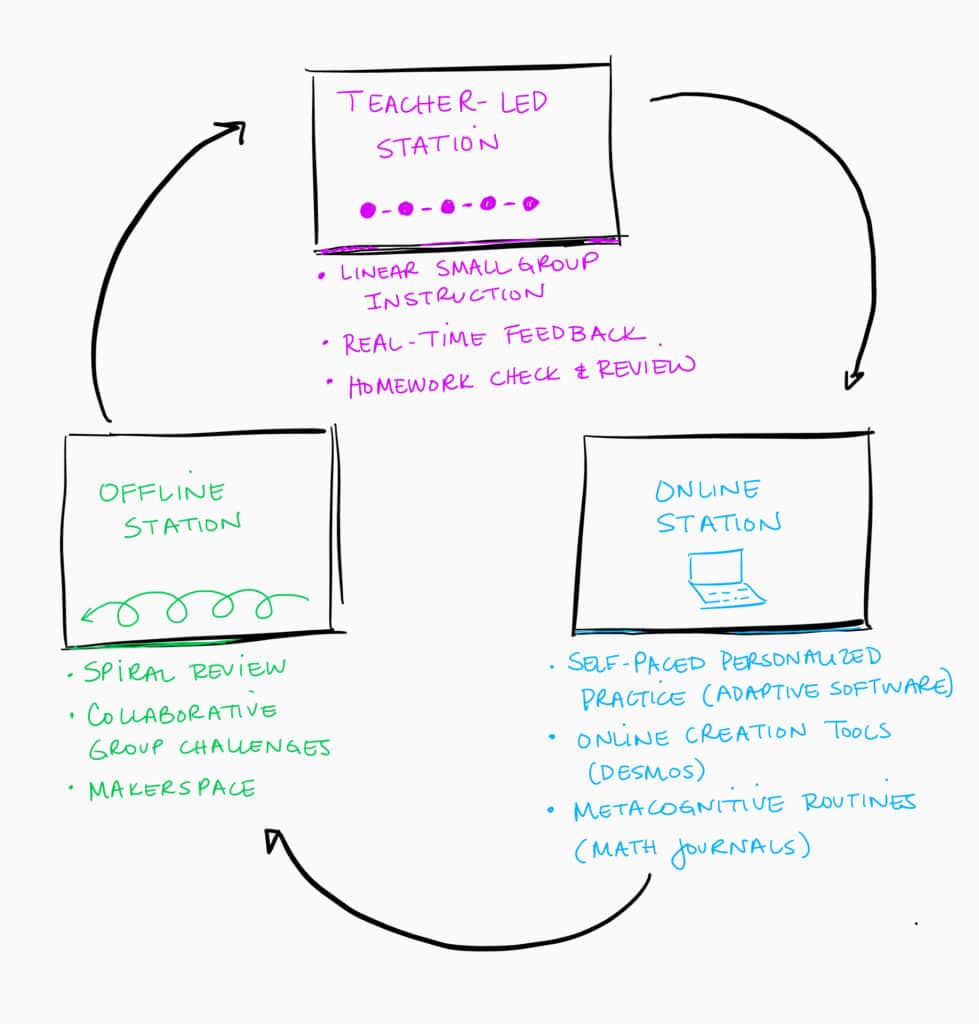Last week in Palm Springs, I had the pleasure of coaching a 9th-grade math teacher. It was exciting to work with a math teacher who was eager to try using the station rotation model in her math classroom.
Math instruction tends to be linear with each lesson building on the one before. This can make it challenging for teachers, who are used to using whole group teacher-led lessons, to transition to blended learning models. The station rotation model poses additional challenges since teachers have a hard time conceptualizing what will happen at the stations that are not the teacher-led station. I hope this blog post will help to provide clarity about how to think about and plan a math station rotation.

When I coach math teachers using the station rotation model, I suggest that they think about the whole week instead of focusing myopically on a single lesson. Taking a week’s view of lesson planning can make planning the various stations more manageable.
It also helps to think about the stations as playing a particular role in the lesson.
- The teacher-led station can build linearly over the course of the week allowing the teacher to progress through the curriculum.
- The online station can be used to engage students in creative application or personalized practice.
- The creative application of mathematical concepts using online tools can give students a degree of agency in the lesson.
- Personalized practice can allow students who are struggling to review concepts while providing students who are ready for the next challenge to move ahead.
- The offline station can then be used to spiral back to review. It is ideal if this spiral review engages students in collaborative problem-solving. This way, students can use each other as resources.

Below are some of the strategies, technology tools, and math resources I use when I am designing a station rotation lesson.

If you have another strategy, technology tool, or math resource you enjoy using, please post a comment and share it!


13 Responses
I recently graduated from the Google Innovator Academy in New York and had a few questions for you on my project. This was the only space I could find to contact you. Thanks,
It might be easier to chat via Twitter if you send me questions there, Andy.
Catlin
@Catlin_Tucker
Hi how do you the time line? How do you practically transition between traditional class and station rotation? How do you set the groups on the Monday? And when do you rotate?
Hi,
I’ve always advocated for using a variety of models. The Station Rotation Model is just one of a few blended learning models I use and encourage teachers to use.
I have a blog I wrote about grouping that may be helpful –> http://catlintucker.com/2018/03/grouping-strategies. I use a range of grouping strategies depending on the learning objective associated with a lesson.
I hope that helps!
Catlin
How often do you run the station rotation? Daily?
Hi Laura,
No, I used lots of different models in my class and encourage the teachers I coach to pair the objectives of the lesson with the best model. Typically, I would spend 2-3 days a week in station rotation mode so I could focus on small group instruction or give real-time feedback as students worked. If I was lucky enough to have access to a Chromebook cart, I might have students self-pace through a hyperdoc or playlist so I could conference individually with students. It just depends on the objectives for the day.
Catlin
Graspable Math https://graspablemath.com and GeoGebra https://www.geogebra.org/?lang=en are two other tools I use with my students.
Thanks for sharing these, Mike!
Take care.
Catlin
Awesome ideas. I was a science lab teacher for grades 3 and 4 but now with no lab, I push in to each class. I am struggling with how to keep some inquiry based learning happening when I don’t have enough materials for the whole school and am not allowed to let them share materials.
Hi Teresa,
Hopefully, other folks with experience can chime in. My son’s school is putting together zip lock bags for pick up of basic materials to make available to kids and providing parents with lists of materials (mostly recyclable stuff that we would throw away) to keep for labs and STEM projects.
Catlin
We use station rotation daily in ELA and the important thing is modeling it for like a MONTH in the beginning of the school year. One thing I have added is a student job called “Ask Me” so I am not interrupted with bathroom / pencil / directions questions in small group….but not they will be wearing a green lanyard……
Thank you for all of your valuabale knowledge!
You’re welcome, Ellen! I could not agree more. Modeling is key! I love the idea of the “Ask Me” lanyard. Constant interruptions at the teacher-led station are so distracting.
Take care.
Catlin
Thank you!